Lesson 7 Public Speaking Skills
Unit 7 Speaking to Persuade 课件外国文学欣赏

Speaking to Persuade
Speaking to persuade
01
persspumeaaasWkikveehesra?at
02
Why do listeners accept one speaker’s views?
03
Hoswmlpiseotceaatinknaveecaarrtts?eto
ways, they are similar in other ways as well.
4. Appealing to emotions
Emotional appeals are intended to make listeners feel sad, angry, afraid, happy, proud or the like.
Conclusion: Only elaborating features of a certain product will not move and touch people and thus will not lead people to make a decision to buy.
General principle:
Speaking to persuade
2. They are convinced by the speaker’s reasoning.
4. They are touched by the speaker’s ideas or language.
1. They perceive the speaker as having high credibility.
George Campbell in his Philosophy of Rhetoric, ‘When persuasion is the end, passion also must be engaged.’有缘学习更多+谓ygd3076考证资 料
(完整版)Lesson_7_Public_Speaking_Skills
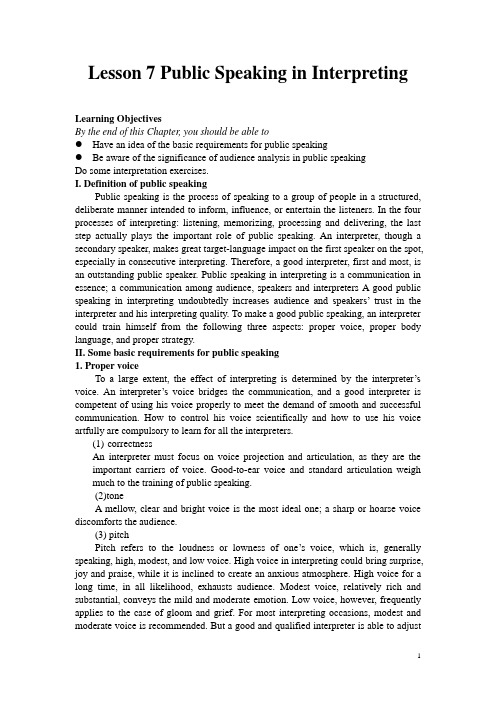
Lesson 7 Public Speaking in Interpreting Learning ObjectivesBy the end of this Chapter, you should be able to●Have an idea of the basic requirements for public speaking●Be aware of the significance of audience analysis in public speakingDo some interpretation exercises.I. Definition of public speakingPublic speaking is the process of speaking to a group of people in a structured, deliberate manner intended to inform, influence, or entertain the listeners. In the four processes of interpreting: listening, memorizing, processing and delivering, the last step actually plays the important role of public speaking. An interpreter, though a secondary speaker, makes great target-language impact on the first speaker on the spot, especially in consecutive interpreting. Therefore, a good interpreter, first and most, is an outstanding public speaker. Public speaking in interpreting is a communication in essence; a communication among audience, speakers and interpreters A good public speaking in interpreting undoubtedly increases audience and speakers’ trust in the interpreter and his interpreting quality. To make a good public speaking, an interpreter could train himself from the following three aspects: proper voice, proper body language, and proper strategy.II. Some basic requirements for public speaking1. Proper voiceTo a large extent, the effect of interpreting is determined by the interpreter’s voice. An interpreter’s voice bridges the communication, and a good interpreter is competent of using his voice properly to meet the demand of smooth and successful communication. How to control his voice scientifically and how to use his voice artfully are compulsory to learn for all the interpreters.(1)correctnessAn interpreter must focus on voice projection and articulation, as they are the important carriers of voice. Good-to-ear voice and standard articulation weigh much to the training of public speaking.(2)toneA mellow, clear and bright voice is the most ideal one; a sharp or hoarse voice discomforts the audience.(3) pitchPitch refers to the loudness or lowness of one’s voice, which is, generally speaking, high, modest, and low voice. High voice in interpreting could bring surprise, joy and praise, while it is inclined to create an anxious atmosphere. High voice for a long time, in all likelihood, exhausts audience. Modest voice, relatively rich and substantial, conveys the mild and moderate emotion. Low voice, however, frequently applies to the case of gloom and grief. For most interpreting occasions, modest and moderate voice is recommended. But a good and qualified interpreter is able to adjusthis pitch to various cases.(4) intonationIntonation is changes about voice fall and rise. Changes in intonation are based on the interpreter’s understanding of source language and the context on the spot. A qualified interpreter will use appropriate, natural and nice intonation to keep audiences’ attention and deliver the fullest contents and sensibilities of the speaker.(5)speedToo fast and too slow are two extremes in interpreting. Under intensive interpreting, an inexperienced interpreter will subconsciously quicken his speed, sometimes words or sentences missing, which fail the audience to catch up with and the audiences lose their interest, trust and patience. Here is a good tip for public speaking speed: the more audience, the moderately slower your speech speed than average. Meanwhile, fast and slow deliveries are alternative in live interpreting, as well as by means of pause and stress.(6) volumeThe basic requirement of public speaking is clearly audible and intelligible. A qualified interpreter, especially in conference interpreting and simultaneous interpreting, will professionally watch and adjust his microphone position and volume, i.e. microphone manners. A certain distance should be kept between interpreter’s mouth and microphone to prevent from distorted sound and pop noise, from gasping, sniffing, coughing and noise-making data reading. To keep voice stable and clear, especially when an interpreter lowers his head to read notes, he will keep a little closer to microphone.2. Proper Body languageBody language is a form of non-verbal communication, which consists of body posture, gestures, facial expressions, and eye movements. Humans send and interpret such signals subconsciously. Body language may provide clues as to the attitude or state of mind of a person. For example, it may indicate aggression, attentiveness, boredom, relaxed state, pleasure, amusement, and intoxication, among many other cues. Therefore, body language is message carrier of communication, which is taken as an indispensable part of public speaking. As an interpreter, he excels not only in verbal expression, but in using body language to complete and compensate meanings and feelings.(1)appearance and presenceAppearance and presence is the initial visual image and non-verbal body language when an interpreter is on the stage or on the spot. Audiences observe his appearance and presence, guessing and creating the first impression on him, which makes directly impact on the interpreting effect. Natural and graceful appearance and presence is the respect to audience that narrows the psychological gap between audience and the interpreter; that wins the attention and respect from audience, and in turn creating harmonious atmosphere. How to have a good appearance and presence? Formal dress or informal dress? The simplest way is to communicate with the host or sponsor and to make an elegant and tact dress.(2) poseProper pose is necessary in public speaking. Standing, sitting or stepping, an interpreter has to be modest and natural. Stand and sit stably, vigorously and energetically; try not to cross legs, shake or lean, bow or bend, look back and forth or left and right. Hands can be seen and available, while it is improper to play with fingers or the corners of clothes, even it is no need taking notes.(3) eye contactEyes are the windows of one’s soul so that calm and confident eye contact is the most exact and active bridge of communication. An interpreter’s proper eye contact impresses audience like an individual contact. A sophisticated interpreter will hold every listener in his eyes, pause or ponder when he sees audience confusing, adjust his interpreting by occasionally looking at audiences and reading notes or references alternatively.(4)facial expressionProper facial expression could convey messages and emotions effectively. Elegant and earnest, calm and confident, affable and amiable facial expression will narrow the distance, double the interpreting effect, and add the mutual trust. Better not exaggerate one’s facial expression, nor be glassy-eyed or a poke face. Try not to frown, make faces and a miserable face, tongue out, and sigh. When there is a slip of the tongue, an interpreter should accept criticism or correctness modestly rather than to frown or pull a straight face. Above-mentioned taboos easily result in adverse effect and lead to centrifugal effect in the end.(5) gestureProper gesture can refine the interpreting; too many gestures of an interpreter are to gild the lily, imperceptibly distracting audiences’attention and dissatisfied them. An experienced interpreter could use gestures moderately and consciously, meanwhile avoid scratching his ears or cheeks.3. Proper strategiesHere are some proper strategies on public speaking training for an interpreter.(1) To have a good habit of completing a sentence after starting interpreting. Better not be a brave beginning and weak ending, nor restart interpreting, nor have constant back-correction.(2) As for the issue of first person or third person in interpreting, generally speaking, first person is more favored in practice. It is the international practice that an interpreter informs the audience the nationality, title and name of the spokesman or spokeswoman and using the first person. But an interpreter takes the interpreting role for many speakers in two-sided or multilateral conference; he should state explicitly the spokesman identity.(3) To train his eloquence in public speaking, an interpreter is recommended to practice three-point skill. That is, to talk three points or three aspects whatever topic or opinion is given, for instance, put forward three evidences, give three reasons or make three examples. Psychologically speaking, two points are insufficient to most audience; four are redundant and easily to forget the second point; three is appropriate and right.Practice of public speakingExercise 1Listen to the following texts once and then start interpreting at the end of each segment.Secretary-General's remarks to the Memorial Ceremony in honor of those killed in the Haiti earthquake in New York, 9 March 2010Excellencies,Dear colleagues,Dear friends,Above all, dear families of those to whom we sadly bid farewell://Let us begin by thanking the families and friends who have traveled far to be with us. To those who could not be here, please know that our hearts are with you. //We are joined by duty stations around the world, the men and women of our proud United Nations. Among them are the members of our UN mission in Haiti, who have carried on despite their pain and hardship. // I thank Mr. Edmond Mulet and his courageous staff who are working tirelessly - day in, day out – in MINUSTAH [UN Stabilization Mission in Haiti]. I highly commend [you] and I am deeply grateful to all of you. //Today, we commemorate the single greatest loss the UN has suffered in its history. We remember 101 lives of consequence. We honor 101 unique paths that joined in Haiti to write the larger story of the United Nations. These women and men were our own. They were family.//They came to Haiti from all corners of the world, from all walks of life. Yet they shared a common conviction, a belief in a better future for the people of Haiti, and a common resolve to help them build it. Now those 101 paths come together one final time, here in this chamber, through us - families and friends, colleagues and loved ones.//The world knew them as trusted diplomats, dedicated humanitarians and conscientious professionals. They were doctors and drivers, police officers and policy advisers, soldiers and lawyers, each contributing to the mission, each in his or her own way.//To us they were even more. We knew them, very personally. We knew their smiles, their songs, their dreams. Now we cannot forget the last email, the last conversation, the last meal together, the last au revoir. Their words echo: "Don't worry about me. This is where I need to be. //"At the United Nations, we don't simply share office space; we share a passion for a better world. So it is no surprise that many of these 101 paths crisscrossed the globethrough the years: in Cambodia and the DRC, Eritrea and East Timor, Kosovo and Sierra Leone. //Whether they came to Haiti, or came from Haiti, they knew that hope shines in even the darkest corners. And so they chased the flame. Wherever they went, they carried the light of hope. //And as they fulfilled their mission in Haiti, they illuminated a profound truth: Earthquakes are a force of nature, but people move the world. //Key words:duty stations:工作地点mission: 任务MINUSTAH(UN Stabilization Mission in Haiti): 联合国海地特派团Commemorate: 缅怀lives of consequence :英烈humanitarian: 人道主义工作者conscientious:良知的crisscrossed:纵横交错的Cambodia:柬埔寨DRC(democratic republic of Congo):刚果民主共和国Eritrea: 厄立特里亚East Timor: 东帝汶Kosovo: 科索沃Sierra Leone: 塞拉利昂Exercise 2胡锦涛在上海世博会欢迎晚宴上的祝酒辞尊敬的国际展览局蓝峰主席、洛塞泰斯秘书长,尊敬的各位国家元首、政府首脑、议长和王室代表,尊敬的各位国际组织代表,尊敬的各位来宾,女士们,先生们,朋友们: //今晚,2010年上海世界博览会将隆重开幕。
英文认知课程教案模板范文

Course Name: English Cognitive Skills DevelopmentSubject: English as a Second Language (ESL)Grade Level: 7th GradeDuration: 10 WeeksTeaching Objectives:1. To enhance students' cognitive abilities through English language learning.2. To develop critical thinking, problem-solving, and analytical skills in English.3. To foster students' ability to apply English in real-life contexts.4. To encourage students to explore diverse cultures and perspectives through English.Teaching Aims:1. To introduce different cognitive skills and strategies in English learning.2. To practice these skills through interactive activities and exercises.3. To evaluate students' progress and provide feedback for continuous improvement.Teaching Methods:1. Interactive discussions2. Group activities3. Role-playing4. Case studies5. Online resources and multimediaTeaching Materials:1. Course textbook2. Handouts and worksheets3. Projector and computer4. Online resources and multimedia materialsTeaching Schedule:Week 1: Introduction to Cognitive SkillsLesson 1: Understanding Cognitive SkillsLesson 2: Introduction to Critical ThinkingLesson 3: Problem-Solving StrategiesHomework: Write a short essay on a topic related to cognitive skills Week 2: Enhancing Memory and ConcentrationLesson 4: Memory TechniquesLesson 5: Concentration ExercisesLesson 6: Group Activity: Memory GameHomework: Create a memory aid for a new vocabulary listWeek 3: Developing Analytical SkillsLesson 7: Analyzing TextsLesson 8: Identifying Main Ideas and Supporting DetailsLesson 9: Group Activity: Analyzing a News ArticleHomework: Write a summary of a short storyWeek 4: Improving Reading ComprehensionLesson 10: Strategies for Reading ComprehensionLesson 11: Practice Reading Comprehension ExercisesLesson 12: Group Activity: Reading a Chapter from a BookHomework: Read a passage and answer comprehension questions Week 5: Enhancing Listening SkillsLesson 13: Listening StrategiesLesson 14: Practice Listening ExercisesLesson 15: Group Activity: Listening to a PodcastHomework: Write a summary of a listening passageWeek 6: Developing Speaking SkillsLesson 16: Public Speaking TechniquesLesson 17: Group Activity: Role-PlayingLesson 18: Presentation SkillsHomework: Prepare a short presentation on a chosen topic Week 7: Improving Writing SkillsLesson 19: Writing TechniquesLesson 20: Practice Writing ExercisesLesson 21: Group Activity: Writing a LetterHomework: Write an essay on a given topicWeek 8: Cultural Awareness and Perspective-TakingLesson 22: Understanding Different CulturesLesson 23: Perspective-Taking ExercisesLesson 24: Group Activity: Cultural ExchangeHomework: Write a reflection on a cultural experienceWeek 9: Review and EvaluationLesson 25: Review of Cognitive SkillsLesson 26: Student PresentationsLesson 27: Group Activity: Cognitive Skills ChallengeHomework: Complete a self-assessment of cognitive skillsWeek 10: Course Conclusion and FeedbackLesson 28: Course Review and ReflectionLesson 29: Student FeedbackLesson 30: Certificate of CompletionHomework: NoneAssessment Methods:1. Class participation and contributions2. Homework assignments3. Group activities and projects4. Final project or presentation5. Self-assessment and peer assessmentAdditional Notes:The teacher should adapt the lesson plan according to the students' needs and interests.Regular feedback and encouragement are essential to students' progress.The course should be conducted in an interactive and engaging manner to maintain students' motivation.。
北师大版高一英语教学计划进度安排
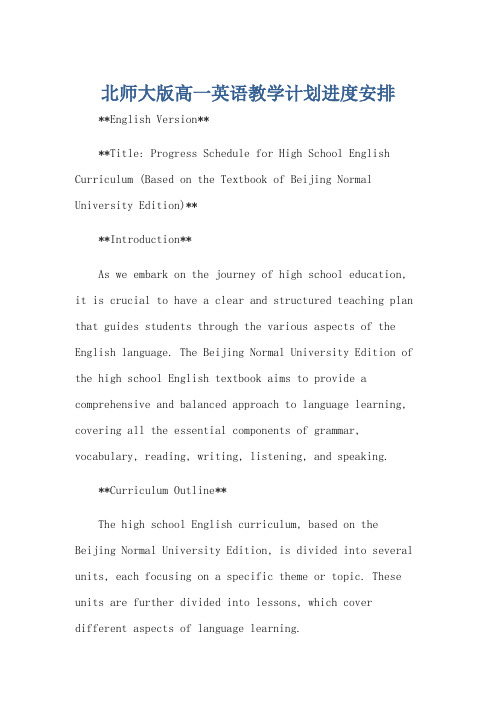
北师大版高一英语教学计划进度安排**English Version****Title: Progress Schedule for High School English Curriculum (Based on the Textbook of Beijing Normal University Edition)****Introduction**As we embark on the journey of high school education, it is crucial to have a clear and structured teaching plan that guides students through the various aspects of the English language. The Beijing Normal University Edition of the high school English textbook aims to provide a comprehensive and balanced approach to language learning, covering all the essential components of grammar, vocabulary, reading, writing, listening, and speaking.**Curriculum Outline**The high school English curriculum, based on the Beijing Normal University Edition, is divided into several units, each focusing on a specific theme or topic. These units are further divided into lessons, which cover different aspects of language learning.**Unit 1: Introduction to High School English*** **Lesson 1**: Overview of the Course and Introduction to the Teacher * **Lesson 2**: Review of Basic Grammar and Vocabulary * **Lesson 3**: Introduction to Reading Comprehension Skills * **Lesson 4**: Introduction to Writing Skills**Unit 2: Exploring English Grammar*** **Lesson 5**: Adjectives and Adverbs * **Lesson 6**: Prepositions and Conjunctions * **Lesson 7**: Sentence Structure and Types * **Lesson 8**: Review and Consolidation**Unit 3: Vocabulary Expansion*** **Lesson 9**: New Vocabulary Introduction * **Lesson 10**: Vocabulary in Context * **Lesson 11**: Word Formation and Roots * **Lesson 12**: Vocabulary Review and Games**Unit 4: Reading Comprehension*** **Lesson 13**: Comprehension of Short Stories ***Lesson 14**: Understanding Poetry and Drama * **Lesson15**: Analyzing Literary Texts * **Lesson 16**: Critical Reading and Discussion**Unit 5: Writing Skills Development*** **Lesson 17**: Essay Writing Basics * **Lesson 18**: Narrative Writing * **Lesson 19**: Argumentative Writing * **Lesson 20**: Creative Writing and Revision**Unit 6: Listening and Speaking Skills*** **Lesson 21**: Listening Comprehension * **Lesson22**: Role-Play and Dialogue Building * **Lesson 23**: Public Speaking and Presentation Skills * **Lesson 24**: Interactive Discussions and Debates**Conclusion**The above-mentioned curriculum schedule provides a solid foundation for high school students to master the English language. By dividing the content into manageable units and lessons, students are able to gradually build their language skills and apply them in real-life situations. The blend of grammar, vocabulary, reading, writing, listening, and speaking ensures a balanced approach to language learning, enabling students to communicate effectively in English.**Chinese Version****标题:北师大版高一英语教学计划进度安排****引言**随着高中教育的开始,我们需要一个清晰而有条理的教学计划,引导学生逐步掌握英语的各个方面。
大学英语自学教程(上下合本)课文英文原文
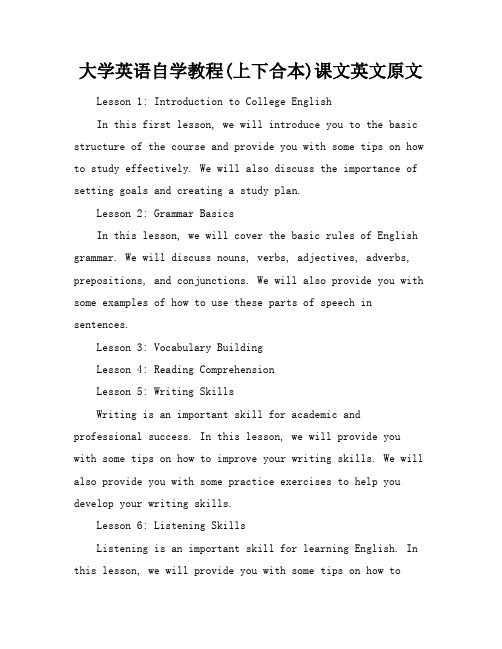
大学英语自学教程(上下合本)课文英文原文Lesson 1: Introduction to College EnglishIn this first lesson, we will introduce you to the basic structure of the course and provide you with some tips on how to study effectively. We will also discuss the importance of setting goals and creating a study plan.Lesson 2: Grammar BasicsIn this lesson, we will cover the basic rules of English grammar. We will discuss nouns, verbs, adjectives, adverbs, prepositions, and conjunctions. We will also provide you with some examples of how to use these parts of speech in sentences.Lesson 3: Vocabulary BuildingLesson 4: Reading ComprehensionLesson 5: Writing SkillsWriting is an important skill for academic and professional success. In this lesson, we will provide you with some tips on how to improve your writing skills. We will also provide you with some practice exercises to help you develop your writing skills.Lesson 6: Listening SkillsListening is an important skill for learning English. In this lesson, we will provide you with some tips on how toimprove your listening skills. We will also provide you with some practice exercises to help you develop your listening skills.Lesson 7: Speaking SkillsLesson 8: Review and AssessmentWe hope that you find this course helpful and enjoyable. Good luck on your journey to mastering the English language!Lesson 9: Cultural AwarenessLesson 10: Advanced GrammarIn this lesson, we will cover more advanced aspects of English grammar, including verb tenses, modal verbs, and passive voice. We will provide you with examples and exercises to help you understand and practice these grammar points.Lesson 11: Academic WritingAcademic writing is an important skill for success in higher education. In this lesson, we will discuss the structure and conventions of academic writing, including essay organization, citation styles, and plagiarism. We will also provide you with some practice exercises to help you develop your academic writing skills.Lesson 12: Pronunciation and Accent ReductionPronunciation is an important aspect of spoken English. In this lesson, we will discuss the phonetic system ofEnglish and provide you with some tips on how to improve your pronunciation and reduce your accent. We will also provide you with some practice exercises to help you develop your pronunciation skills.Lesson 13: English for Specific PurposesEnglish is used in a wide range of fields, including business, medicine, and law. In this lesson, we will explore some specialized vocabulary and expressions used in these fields. We will also provide you with some practice exercises to help you develop your English skills for specific purposes.Lesson 14: Conversation PracticeLesson 15: Final ProjectLesson 16: Advanced Reading StrategiesLesson 17: Public SpeakingPublic speaking is a valuable skill in many professional settings. In this lesson, we will discuss techniques for effective public speaking, including speech organization, delivery, and audience engagement. We will provide you with opportunities to practice delivering speeches and receive feedback to improve your public speaking skills.Lesson 18: Advanced Listening ComprehensionLesson 19: English for Travel and TourismLesson 20: English for Job InterviewsLesson 21: Advanced Writing TechniquesIn this lesson, we will explore advanced writing techniques, such as persuasive writing, argumentative writing, and creative writing. We will provide you with writingprompts and guidelines to help you develop your writingskills in different genres.Lesson 22: English for Social MediaLesson 23: English for Academic ResearchConducting academic research requires strong English language skills. In this lesson, we will discuss techniquesfor reading and understanding academic articles, as well as how to write research papers and cite sources correctly. Wewill provide you with practice exercises to enhance your academic research skills.Lesson 24: English for International RelationsIf you are interested in pursuing a career ininternational relations, this lesson will be beneficial. Wewill explore the language used in diplomacy, negotiations,and international conferences. We will provide you with examples and exercises to help you develop your Englishskills in this specialized field.Lesson 25: Final ReflectionWe hope that this College English SelfStudy Course has equipped you with the necessary tools and knowledge to excelin your English language abilities. Remember to practiceregularly, seek opportunities for language immersion, and never stop learning. Good luck in all your endeavors!。
英语课有趣的惩罚方式作文
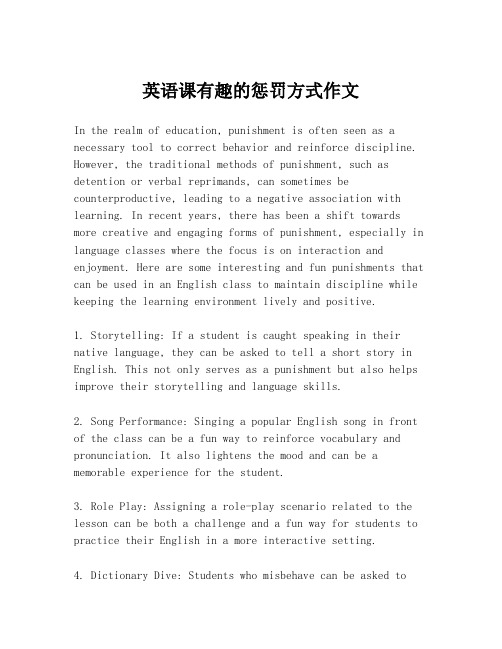
英语课有趣的惩罚方式作文In the realm of education, punishment is often seen as a necessary tool to correct behavior and reinforce discipline. However, the traditional methods of punishment, such as detention or verbal reprimands, can sometimes be counterproductive, leading to a negative association with learning. In recent years, there has been a shift towards more creative and engaging forms of punishment, especially in language classes where the focus is on interaction and enjoyment. Here are some interesting and fun punishments that can be used in an English class to maintain discipline while keeping the learning environment lively and positive.1. Storytelling: If a student is caught speaking in their native language, they can be asked to tell a short story in English. This not only serves as a punishment but also helps improve their storytelling and language skills.2. Song Performance: Singing a popular English song in front of the class can be a fun way to reinforce vocabulary and pronunciation. It also lightens the mood and can be a memorable experience for the student.3. Role Play: Assigning a role-play scenario related to the lesson can be both a challenge and a fun way for students to practice their English in a more interactive setting.4. Dictionary Dive: Students who misbehave can be asked tofind and use an obscure word from the dictionary in a sentence. This encourages them to explore the language more deeply.5. English Stand-Up Comedy: A humorous monologue or joke in English can be a light-hearted way for students to express themselves while also learning about humor and cultural references.6. Word Puzzle Creator: Punish students by asking them to create an English word puzzle, such as a crossword or word search, for the class. This can be a fun way to reinforce vocabulary and critical thinking.7. Class Reporter: The student can be the class reporter fora day, tasked with summarizing the day's lesson in English and presenting it to the class. This can improve their summarization and public speaking skills.8. Peer Teaching: If a student is found not paying attention, they can be asked to teach a short lesson to their peers on a topic related to the class material. This can be a rewarding experience as it puts the student in the role of a teacher.9. English Debate: Engage the student in a friendly debate with a classmate on a topic of the teacher's choosing. This can sharpen their argumentative skills and quick thinking in English.10. Creative Writing: Writing a short poem or essay on a random topic can be a creative outlet for students and a wayto express their feelings in English.These punishments are designed to be constructive and enjoyable, ensuring that students learn from their mistakes while also enhancing their English language skills. By making the punishment process a part of the learning experience, teachers can foster a more positive and engaging classroom environment.。
牛津深圳版七年级上册英语U7 Speaking-最新
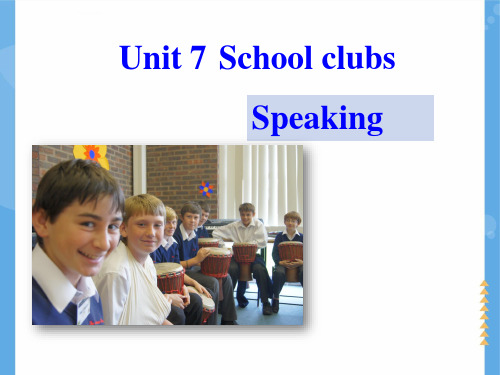
/Id/
asked disppeared attended
w alked ed carried
stopped dialled
Unit 7 Speaking
Part III While-Learning
Talk time
Read the words after the tape.
Unit 7 Speaking
Unit 7 Speaking
二. 根据下面的信息内容,补全对话。
A. how to read poems B. Yes, I did
C. Where D. at 8 o'clock in the morning
E. the Poems Club
F. No, I didn't
Leo: We met at the library.
Unit 7 Speaking
A. how to read poems B. Yes, I did
C. Where
D. at 8 o'clock in the morning
E. the Poems Club
F. No, I didn't
Linda: What did you do at the club?
Leo: We learnt (4) ___A____.
Linda: Did you like the club?
Leo: (5) ___B____. I learnt a lot about poems.
It was great fun reading poems aloud.
Unit 7 Speaking
挑战自己,请快速朗读下面的绕口令。 John, where Molly had had 'had ', had had 'had had'。 'had had' had had the teacher's approval.
英语听说课教案(精选)ppt

Classroom Interaction Methods
01
Student-Centered Learning
This method emphasizes student participation and active
learning. The teacher acts as a facilitator, encouraging students
Summary and feedback section
Motivation
Use an interesting anecdote, video, or interactive activity to spark students' interest and encourage their participation.
Preview
Provide a brief overview of the key points to be covered during the lesson, ensuring students understand what is expected of them.
Oral Training Methods
Role-Playing Method
In this method, students act out different roles in a scenario, speaking in English. It improves fluency, pronunciation, and
四川农业大学英语教材
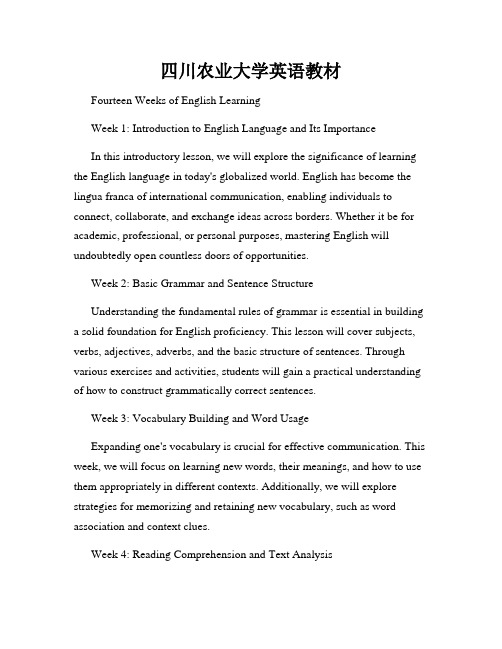
四川农业大学英语教材Fourteen Weeks of English LearningWeek 1: Introduction to English Language and Its ImportanceIn this introductory lesson, we will explore the significance of learning the English language in today's globalized world. English has become the lingua franca of international communication, enabling individuals to connect, collaborate, and exchange ideas across borders. Whether it be for academic, professional, or personal purposes, mastering English will undoubtedly open countless doors of opportunities.Week 2: Basic Grammar and Sentence StructureUnderstanding the fundamental rules of grammar is essential in building a solid foundation for English proficiency. This lesson will cover subjects, verbs, adjectives, adverbs, and the basic structure of sentences. Through various exercises and activities, students will gain a practical understanding of how to construct grammatically correct sentences.Week 3: Vocabulary Building and Word UsageExpanding one's vocabulary is crucial for effective communication. This week, we will focus on learning new words, their meanings, and how to use them appropriately in different contexts. Additionally, we will explore strategies for memorizing and retaining new vocabulary, such as word association and context clues.Week 4: Reading Comprehension and Text AnalysisThe ability to comprehend written texts is a vital skill in language learning. During this week, students will improve their reading comprehension through a variety of texts ranging from short stories to newspaper articles. We will also delve into techniques for analyzing texts, including identifying main ideas, understanding author's tone, and making inferences.Week 5: Listening Skills and Verbal CommunicationListening comprehension plays a significant role in effective communication. This week, students will focus on improving their ability to understand spoken English in various contexts. Through interactive exercises, audio recordings, and group discussions, students will develop their listening skills and learn how to engage in meaningful conversations.Week 6: Writing Strategies and Composition DevelopmentBuilding on the previous weeks' lessons, we will now dive into the art of writing. Students will learn different strategies for organizing their thoughts, structuring their compositions, and effectively conveying their ideas through written form. From basic paragraphs to essays, this week will provide students with the necessary tools to become proficient writers.Week 7: Grammar Review and Verb TensesTo reinforce the knowledge gained in previous weeks and address common grammar mistakes, we will dedicate this week to a comprehensive review of grammar rules, particularly focusing on verb tenses. Students will have the opportunity to practice using different verb tenses correctly, ensuring their written and spoken English is grammatically accurate.Week 8: Idioms and PhrasesIdioms and phrases add color and depth to language. During this week, students will explore commonly used English idioms and phrases and understand their meanings in context. By incorporating idiomatic expressions into their conversations and writing, students will enhance their language proficiency and sound more fluent.Week 9: Cultural Awareness and Cross-Cultural CommunicationLanguage learning goes beyond grammar and vocabulary; it also involves understanding cultural nuances and effectively communicating in a cross-cultural setting. This week will focus on raising students' awareness of different cultures, promoting cultural sensitivity, and equipping them with the necessary skills to navigate multicultural environments with ease.Week 10: Oral Presentations and Public SpeakingConfidently expressing oneself in front of an audience is a valuable skill in both academic and professional settings. This week, students will learn the art of delivering effective oral presentations. Through practice sessions and constructive feedback, students will develop their public speaking skills and refine their ability to deliver engaging and persuasive speeches.Week 11: Academic Writing and Research SkillsAs students progress in their academic journey, the demand for well-researched and documented written assignments increases. This week will focus on developing academic writing skills, including research techniques, citation styles, and structuring research papers. Students will gain the tools necessary to excel in their academic endeavors.Week 12: Test Preparation and Exam StrategiesPreparation is key to success in any examination. During this week, students will receive guidance on test-taking strategies, time management, and problem-solving techniques. Practice tests will be provided to familiarize students with the format and types of questions commonly found in English proficiency exams.Week 13: Business English and Professional CommunicationEnglish proficiency is highly sought after in the business world. This week, students will delve into the language and communication skills necessary for professional settings. From writing effective business emails to conducting successful job interviews, students will learn how to navigate the business world with confidence and competency.Week 14: Language Review and Final AssessmentIn the final week of the course, students will have the opportunity to review all the topics covered throughout the semester. A comprehensive assessment will be conducted to evaluate students' language proficiency growth and provide valuable feedback for future learning.Conclusion:Fourteen weeks of English learning at Sichuan Agricultural University will equip students with the necessary language skills and knowledge to confidently communicate in English. Through a comprehensive curriculum, students will develop their listening, speaking, reading, and writing abilities, enabling them to excel in both academic and professional endeavors. With dedication and consistent practice, students will become proficient Englishusers, prepared to navigate the multicultural and interconnected world we live in.。
核心素养导向的 14种英语课型设计框架及课例解读(中学教师版)
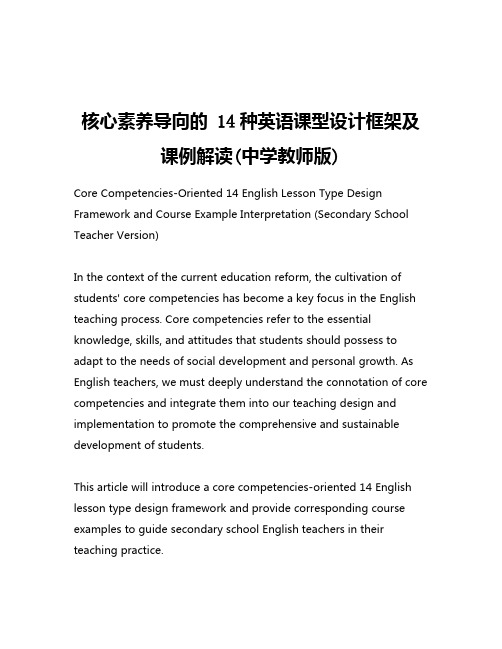
核心素养导向的 14种英语课型设计框架及课例解读(中学教师版)Core Competencies-Oriented 14 English Lesson Type Design Framework and Course Example Interpretation (Secondary School Teacher Version)In the context of the current education reform, the cultivation of students' core competencies has become a key focus in the English teaching process. Core competencies refer to the essential knowledge, skills, and attitudes that students should possess to adapt to the needs of social development and personal growth. As English teachers, we must deeply understand the connotation of core competencies and integrate them into our teaching design and implementation to promote the comprehensive and sustainable development of students.This article will introduce a core competencies-oriented 14 English lesson type design framework and provide corresponding course examples to guide secondary school English teachers in their teaching practice.1. Situational Dialogue LessonThe situational dialogue lesson aims to cultivate students' communicative competence by creating authentic language scenarios. Teachers can design dialogues based on real-life situations, such as ordering food in a restaurant, booking a hotel room, or introducing oneself at a party. Students are required to actively participate in the dialogue, expressing their ideas and emotions appropriately and fluently. Through this type of lesson, students can develop their listening, speaking, and interactive skills, as well as their cultural awareness.Example course: Ordering a Meal at a RestaurantIn this lesson, students will learn how to order a meal at a restaurant. The teacher will first introduce common restaurant vocabulary and expressions, such as menu items, dining etiquette, and polite requests. Then, the teacher will present a model dialogue between a customer and a waiter. Students will be divided into pairs to practice the dialogue, taking turns playing the roles of the customer and the waiter. The teacher will provide feedback and guidance to help students improve their pronunciation, intonation, and pragmatic skills. Finally, students will be asked to create their own dialogues based on different restaurant scenarios, demonstrating their abilityto apply the learned language skills.2. Integrated Skills LessonThe integrated skills lesson aims to develop students' comprehensive language abilities by integrating multiple language skills (listening, speaking, reading, and writing) within a single lesson. Teachers can design lessons that focus on a specific topic or theme, such as environmental protection, technology, or cultural traditions, and guide students to engage in various language activities that involve different skill combinations.Example course: Exploring Environmental Issues through Multimedia In this lesson, students will explore environmental issues through the integration of listening, speaking, reading, and writing skills. The teacher will start by showing a video about the impact of plastic pollution on the environment. Students will then participate in a class discussion, sharing their thoughts and opinions on the issue. Next, the teacher will provide a reading passage that delves deeper into the causes and consequences of plastic waste. Students will work in groups to analyze the text and identify key information. Finally, students will be asked to write a persuasive essay, proposing solutions to address the plastic pollution problem and encouraging their peers to take action.3. Literature-based LessonThe literature-based lesson aims to cultivate students' literary appreciation and critical thinking skills by engaging them with literary works, such as poems, short stories, or excerpts from novels.Teachers can guide students to analyze the themes, characters, and literary devices employed in the texts, as well as encourage them to express their personal interpretations and reflections.Example course: Exploring the Theme of Love in "The Gift of the Magi"In this lesson, students will explore the theme of love through the analysis of the short story "The Gift of the Magi" by O. Henry. The teacher will first provide background information on the author and the historical context of the story. Students will then read the text and discuss the central characters, their motivations, and the symbolic significance of the gifts they exchange. The teacher will guide students to examine how the theme of love is conveyed through the plot, character development, and the use of literary devices. Finally, students will be asked to write a personal response essay, reflecting on the messages about love and sacrifice presented in the story and how they relate to their own experiences.4. Project-based LessonThe project-based lesson aims to foster students' creativity, problem-solving skills, and collaborative abilities by engaging them in a comprehensive, multi-step project. Teachers can design projects that require students to research, plan, and execute a specific task or product, such as creating a school magazine, organizing a cultural event, or developing a mobile application.Example course: Designing a School MagazineIn this lesson, students will work in groups to design and produce a school magazine. The teacher will first introduce the project and its objectives, which may include showcasing the school's achievements, highlighting student talents, and promoting school spirit. Students will then brainstorm ideas for the magazine's content, layout, and target audience. They will divide tasks, such as conducting interviews, writing articles, and designing the magazine's visual elements. Throughout the process, the teacher will provide guidance and feedback to help students refine their work. Finally, students will present their completed magazine to the class and receive peer and teacher evaluation.5. Flipped Classroom LessonThe flipped classroom lesson aims to promote active learning and student-centered instruction by reversing the traditional lecture-and-homework model. In this approach, students first engage with the learning materials, such as pre-recorded video lessons or reading assignments, outside of the classroom. During the class session, the teacher facilitates interactive activities, discussions, and problem-solving exercises to deepen students' understanding of the content.Example course: Exploring British Literature through Flipped Learning In this lesson, students will explore British literature through aflipped classroom approach. Before the class, students will be assigned to watch a video lecture on the historical and cultural context of British literature. They will also be asked to read a selected poem or short story by a renowned British author. During the class, the teacher will facilitate a discussion on the key themes, literary devices, and cultural significance of the literary work. Students will then work in groups to analyze and interpret the text, sharing their insights and perspectives with the class. The teacher will provide feedback and guidance to help students develop their critical thinking and literary analysis skills.6. Inquiry-based LessonThe inquiry-based lesson aims to cultivate students' curiosity, research skills, and independent learning abilities by engaging them in the process of inquiry and discovery. Teachers can design lessons that encourage students to ask questions, gather information, and construct their own understanding of a topic or issue.Example course: Investigating the Impact of Artificial Intelligence on SocietyIn this lesson, students will investigate the impact of artificial intelligence (AI) on society. The teacher will begin by presenting a thought-provoking question or problem related to the topic, such as "How will AI affect employment opportunities in the future?" Students will then work in groups to formulate their own researchquestions and develop an investigation plan. They will gather information from various sources, including online articles, academic papers, and expert interviews. Throughout the process, the teacher will guide students in evaluating the reliability of sources, analyzing the data, and drawing conclusions. Finally, each group will present their findings and recommendations to the class, engaging in a discussion on the potential benefits and challenges of AI integration in our society.7. Simulation-based LessonThe simulation-based lesson aims to provide students with authentic, hands-on learning experiences by creating simulated environments or scenarios. Teachers can design lessons that allow students to role-play, participate in decision-making processes, or engage in problem-solving activities that mirror real-world situations.Example course: Negotiating a Business Deal in a Global MarketIn this lesson, students will participate in a simulation-based activity to negotiate a business deal in a global market. The teacher will divide the class into small groups, each representing a different company or organization. Each group will be assigned a specific product or service to negotiate, as well as a set of objectives, constraints, and cultural considerations. Students will then engage in a role-play negotiation, using their communication, problem-solving, and cross-cultural skills to reach an agreement. The teacher willobserve the negotiations, providing feedback and guidance to help students navigate the complexities of international business interactions.8. Debate-oriented LessonThe debate-oriented lesson aims to develop students' critical thinking, argumentation, and public speaking skills by engaging them in structured debates on controversial or thought-provoking topics. Teachers can guide students through the process of researching, organizing, and presenting their arguments, as well as teaching them effective debating techniques and strategies.Example course: Debating the Impact of Social Media on Mental HealthIn this lesson, students will participate in a debate on the impact of social media on mental health. The teacher will first introduce the topic and provide background information on the potential positive and negative effects of social media usage. Students will then be divided into two teams, with one team arguing in favor of the positive impact and the other team arguing against it. Each team will be given time to research the topic, gather evidence, and prepare their arguments. During the debate, students will take turns presenting their case, responding to the opposing team's arguments, and engaging in rebuttal. The teacher will moderate the debate and provide feedback on the students' critical thinking, communication,and argumentation skills.9. Gamification-based LessonThe gamification-based lesson aims to enhance student engagement and motivation by incorporating game-like elements into the learning process. Teachers can design lessons that feature interactive games, simulations, or competitive activities to help students acquire and apply their knowledge in a fun and engaging manner.Example course: Vocabulary Acquisition through Word GamesIn this lesson, students will learn and practice English vocabulary through a series of word games. The teacher will begin by introducing a set of target vocabulary words, providing definitions and contextual examples. Students will then participate in various word games, such as Hangman, Scrabble, or Crossword puzzles, to reinforce their understanding of the new vocabulary. The games will be designed to challenge students' spelling, word associations, and strategic thinking skills. Throughout the lesson, the teacher will monitor the students' progress, offer guidance, and facilitate friendly competition among the teams or individuals.10. Differentiated Instruction LessonThe differentiated instruction lesson aims to cater to the diverse learning needs, preferences, and abilities of students within the same classroom. Teachers can design lessons that offer multiple entrypoints, learning activities, and assessment options, allowing students to engage with the content in a way that best suits their individual strengths and learning styles.Example course: Developing Writing Skills through Differentiated InstructionIn this lesson, students will work on developing their English writing skills through a differentiated approach. The teacher will begin by assessing the students' current writing abilities and learning preferences. Based on this information, the teacher will provide a range of writing tasks and activities, such as free-writing, guided paragraphs, or essay outlines, that address different skill levels and learning styles. Students will have the flexibility to choose the tasks that best match their needs and interests. The teacher will then provide personalized feedback and support, guiding students in the writing process and helping them to improve their organization, coherence, and language use.11. Interdisciplinary LessonThe interdisciplinary lesson aims to foster students' ability to make connections between different subject areas and apply their knowledge in a holistic manner. Teachers can design lessons that integrate content and skills from multiple disciplines, such as English, history, science, or art, to provide a more comprehensive and meaningful learning experience.Example course: Exploring the Influence of Literature on Social ChangeIn this lesson, students will explore the influence of literature on social change, integrating concepts and skills from both the English and social studies disciplines. The teacher will start by introducing a selection of literary works, such as novels, plays, or poems, that have been instrumental in driving social movements or advocating for societal reforms. Students will then analyze the themes, characters, and literary techniques employed in these works, examining how the authors used their craft to raise awareness, challenge societal norms, or inspire action. The lesson will also incorporate historical context and current events to help students understand the broader social and political implications of the literary works. Finally, students will be asked to write a research paper or create a multimedia presentation that explores the relationship between literature and social change, drawing connections between the past and present.12. Blended Learning LessonThe blended learning lesson aims to leverage the benefits of both online and face-to-face instruction to create a more dynamic and personalized learning experience. Teachers can design lessons that combine digital resources, such as online lectures, interactive simulations, or virtual collaborations, with traditional classroom activities, such as group discussions, hands-on projects, or one-on-one consultations.Example course: Enhancing Listening Comprehension through Blended LearningIn this lesson, students will improve their English listening comprehension skills through a blended learning approach. Before the class, students will be assigned to watch a series of online video lectures that cover various listening strategies, such as predicting content, identifying key information, and using contextual cues. They will also be asked to complete online quizzes and exercises to reinforce their understanding of the concepts. During the class session, the teacher will facilitate interactive activities and discussions that allow students to apply the listening strategies to authentic audio or video materials. Students will work in pairs or small groups to practice their listening skills, providing peer feedback and engaging in collaborative problem-solving. The teacher will also offer individual guidance and support to help students overcome their specific listening challenges.13. Reflective Learning LessonThe reflective learning lesson aims to cultivate students' metacognitive skills and self-awareness by encouraging them to reflect on their learning process, strengths, and areas for improvement. Teachers can design lessons that involve self-assessment, goal-setting, and the development of personalizedlearning plans.Example course: Developing Learner Autonomy through Reflection In this lesson, students will engage in a reflective learning process to develop their autonomy as English language learners. The teacher will first guide students in assessing their current English proficiency levels, learning preferences, and personal goals. Students will then be asked to create a learning plan that outlines their short-term and long-term objectives, as well as the specific strategies and resources they will use to achieve these goals. Throughout the lesson, the teacher will provide opportunities for students to reflect on their progress, celebrate their successes, and identify areas for further development. Students will also engage in peer-to-peer feedback and share their reflections, learning from each other's experiences and insights.14. Integrated Technology LessonThe integrated technology lesson aims to leverage digital tools and resources to enhance the learning experience and prepare students for the demands of the 21st-century digital world. Teachers can design lessons that incorporate various educational technologies, such as online collaboration platforms, multimedia presentations, or data visualization tools, to support and enrich the learning process.Example course: Enhancing Presentation Skills through Digital ToolsIn this lesson, students will develop their English presentation skills using integrated technology. The teacher will first introduce a range of digital tools and platforms that can be used to create engaging and effective presentations, such as slideshow software, video editing applications, and online collaboration boards. Students will then be given a topic or task related to their English curriculum and asked to plan and design a multimedia presentation using the available digital resources. During the presentation phase, students will have the opportunity to showcase their work, receive peer and teacher feedback, and engage in discussions. The teacher will also provide guidance on best practices for using technology to enhance the clarity, creativity, and impact of the presentations.In conclusion, the 14 English lesson types presented in this article offer a comprehensive framework for designing and delivering core competencies-oriented lessons in secondary school English classrooms. By implementing these lesson types, English teachers can foster the development of students' essential knowledge, skills, and attitudes, preparing them for academic success and lifelong learning. The provided course examples serve as a starting point for teachers to adapt and apply these lesson types to their specific teaching contexts, ultimately enhancing the quality and effectiveness of English language instruction.。
我的教育教学经验3000字英语作文
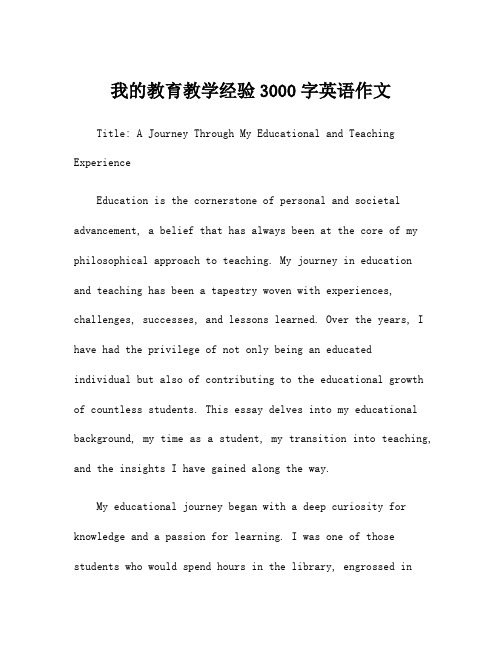
我的教育教学经验3000字英语作文Title: A Journey Through My Educational and Teaching ExperienceEducation is the cornerstone of personal and societal advancement, a belief that has always been at the core of my philosophical approach to teaching. My journey in education and teaching has been a tapestry woven with experiences, challenges, successes, and lessons learned. Over the years, I have had the privilege of not only being an educatedindividual but also of contributing to the educational growth of countless students. This essay delves into my educational background, my time as a student, my transition into teaching, and the insights I have gained along the way.My educational journey began with a deep curiosity for knowledge and a passion for learning. I was one of those students who would spend hours in the library, engrossed inbooks, eager to absorb every bit of information. My parents, both educators themselves, instilled in me the value of education from a young age. They believed that education was not just about acquiring facts but about developing critical thinking skills, creativity, and a lifelong love for learning.As I progressed through my academic career, I foundmyself drawn to subjects that allowed me to explore thedepths of human thought and interaction. Literature, history, and psychology were my favorites because they providedwindows into the complexities of the human experience. In college, I majored in English Literature, which allowed me to immerse myself in the richness of language and the power of storytelling.My undergraduate years were transformative. I wasfortunate to be mentored by professors who recognized my potential and encouraged me to think critically and expressmy ideas with clarity and conviction. I participated innumerous debates, workshops, and seminars, which honed my public speaking skills and deepened my understanding ofdiverse perspectives. These experiences laid the groundworkfor my future in education.After completing my undergraduate degree, I pursued a Master's in Education with a focus on curriculum development and instructional strategies. It was during this time that I discovered my passion for teaching. The theoreticalfoundations I learned were complemented by practical experiences in the classroom. I observed various teaching methods, analyzed lesson plans, and worked closely with educators to understand the intricacies of effective teaching.My first teaching position was at a local high school where I taught English Literature. The transition from beinga student to a teacher was challenging yet exhilarating. I quickly realized that teaching was not just about conveying information; it was about inspiring young minds, fostering asafe learning environment, and encouraging students to question, explore, and think independently.One of my most memorable experiences was with a group of students who initially showed little interest in literature. Through creative lesson planning and engaging activities, I managed to spark their curiosity and ignite a love for reading and analysis. By the end of the semester, these students were actively participating in class discussions, expressing their thoughts with confidence, and even choosing to read beyond the assigned material. This transformation was a testament to the power of teaching and the impact it can have on individual students.Throughout my career, I have adopted various teaching styles to cater to different learning preferences. I believe in the importance of differentiated instruction, whereby each student is provided with personalized support to meet their unique needs. This approach has been particularly effectivein inclusive classrooms, where students with diverse backgrounds and abilities learn together.I have also embraced technology as an educational tool, integrating multimedia resources and online platforms to enhance the learning experience. However, I am keenly aware of the balance that must be struck between traditional teaching methods and modern technological advances. There is no substitute for face-to-face interactions, hands-on activities, and the personal touch that a teacher brings to the classroom.Reflecting on my educational and teaching experience, I have come to appreciate the profound influence that teachers can have on the lives of their students. We are not merely facilitators of knowledge but catalysts for change, guiding our students towards becoming informed, empathetic, and responsible citizens of the world.In conclusion, my journey in education and teaching has been filled with moments of joy, reflection, and growth. From my early days as an enthusiastic learner to my current role as an educator, I have witnessed firsthand the transformative power of education. It is a constant learning process, requiring patience, adaptability, and a deep commitment to our students' success. As I continue on this path, I am reminded daily of the responsibility I hold in shaping young minds and the immense satisfaction that comes with seeing my students thrive.。
英语口译基础课程教案
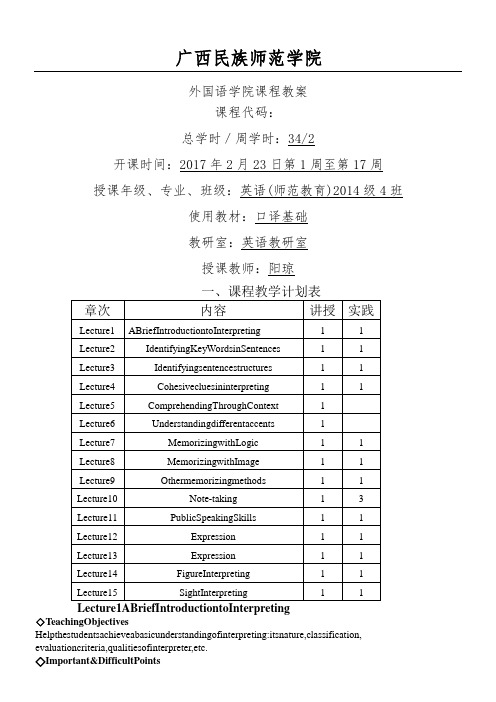
广西民族师范学院外国语学院课程教案课程代码:总学时/周学时:34/2开课时间:2017年2月23日第1周至第17周授课年级、专业、班级:英语(师范教育)2014级4班使用教材:口译基础教研室:英语教研室授课教师:阳琼Lecture1ABriefIntroductiontoInterpreting◇TeachingObjectivesHelpthestudentsachieveabasicunderstandingofinterpreting:itsnature,classification, evaluationcriteria,qualitiesofinterpreter,etc.◇Important&DifficultPoints1.Thenatureandevaluationcriteriaofinterpreting;2.Therequirementsofqualifiedinterpreter.◇Teaching MethodsCommunicativeteachingapproach◇Teaching ProceduresStep1Greeting(3mins)TheTeacherintroducesherselfStep2Lead-in(10mins)Coursedescription.?Step3Overview?of?Interpretation(40mins)1.Definition?of?InterpretationInterpretation?is?a?vocal?translation?to?the?information?delivered?by?vocal?utterance ?and?text.?2.Characteristics?of?Interpretation?*?Unpredictability??*?Bearing?on?big?pressure??????*?Independency??*?Comprehensive?language?and?skill?operations???????*?Extensive?communicative?information3.?Criteria?of?Interpretation?*accuracy?*fluency??4.?Process?of?Interpretation5.InterpreterQualificationRequirementsConformtotheForeignaffairsdisciplineSolidbilingualbasisCompleteabilityofutteranceQuick-mindedLearnedGoodmannerStep4Practices:Dialogue&passageinterpreting(30mins)会展中心介绍Vocabulary:国际会展中心InternationalExhibitionCenter仓储warehousing室内展厅indoorexhibitionarea室外展厅outdoorexhibitionarea中国国际投资贸易洽谈会ChinaInternationalFairforInvestmentandTrade国际石材展InternationalStoneFair体博会Sports&LeisureGoodsFair大堂lobby拖车trailer展位both多功能multi-functional装卸平台loadingplatformStep5Assignments(2mins)PreviewthecontentofUnit1.Lecture2IdentifyingKeyWordsinSentences◇TeachingobjectivesAttheendofthelesson,studentsshouldbeableto:1.identifykeywordsinsentenceswhilelisteningtothesourcelanguage;2.masterkeywords,expressionsandsentencesonareception3.improveinterpretingskillsandpractice◇Keypointstheabilitytoidentifykeyinformationthroughkeywords◇TeachingAllotment:2periods◇TeachingMethods:communicativeapproach;audio-lingualapproach◇TeachingProcedures:Step1Greeting&Warming-upStep2Interpretingskills(10mins)PleasegothroughPart1quicklyandfindtheanswerstothefollowingquestions.1)Whatstandardsdointerpretershavetomeetasforlistening?2)Whatistheso-called“keyword”inasentence?3)Fromwhichfourperspectivescanweidentifykeywordsinasentencetograspthekeyinformation?Step3Practices(65mins)(1)Sentenceinterpreting(15mins)1)对不起,您是来自英国电信(BritishTelegraph)的LisaAnderson女士吗?2)自上次在巴黎匆匆一晤,我们都好几年没见面了。
英语配音教学教案初中
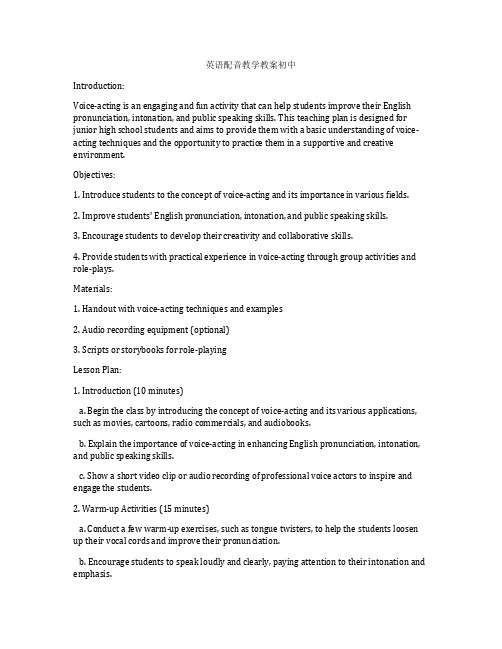
英语配音教学教案初中Introduction:Voice-acting is an engaging and fun activity that can help students improve their English pronunciation, intonation, and public speaking skills. This teaching plan is designed for junior high school students and aims to provide them with a basic understanding of voice-acting techniques and the opportunity to practice them in a supportive and creative environment.Objectives:1. Introduce students to the concept of voice-acting and its importance in various fields.2. Improve students' English pronunciation, intonation, and public speaking skills.3. Encourage students to develop their creativity and collaborative skills.4. Provide students with practical experience in voice-acting through group activities and role-plays.Materials:1. Handout with voice-acting techniques and examples2. Audio recording equipment (optional)3. Scripts or storybooks for role-playingLesson Plan:1. Introduction (10 minutes)a. Begin the class by introducing the concept of voice-acting and its various applications, such as movies, cartoons, radio commercials, and audiobooks.b. Explain the importance of voice-acting in enhancing English pronunciation, intonation, and public speaking skills.c. Show a short video clip or audio recording of professional voice actors to inspire and engage the students.2. Warm-up Activities (15 minutes)a. Conduct a few warm-up exercises, such as tongue twisters, to help the students loosen up their vocal cords and improve their pronunciation.b. Encourage students to speak loudly and clearly, paying attention to their intonation and emphasis.3. Voice-Acting Techniques (20 minutes)a. Introduce key voice-acting techniques, such as adjusting pitch, using different accents, and incorporating facial expressions and gestures.b. Provide examples and practice exercises for each technique, allowing students to actively participate and practice in pairs or small groups.c. Demonstrate how to use these techniques while performing a short script or storybook.4. Role-Plays (25 minutes)a. Divide the class into small groups and assign each group a script or storybook to work on.b. Instruct each group to practice their role-plays, incorporating the voice-acting techniques they have learned.c. Encourage students to be creative and have fun while performing their role-plays.5. Presentations (15 minutes)a. Ask each group to present their role-play in front of the class.b. Provide positive feedback and constructive criticism to help students improve their voice-acting skills.c. Encourage students to share their experiences and what they have learned from the activity.6. Wrap-up (5 minutes)a. Summarize the main points covered in the lesson and emphasize the importance of practice and perseverance in improving voice-acting skills.b. Encourage students to continue practicing voice-acting outside of the classroom, such as by recording themselves or participating in school plays and events.Assessment:1.观察学生在角色扮演中的表现,包括他们的语音语调、表情和创造力。
公共英语新概念精讲第七课口语学习
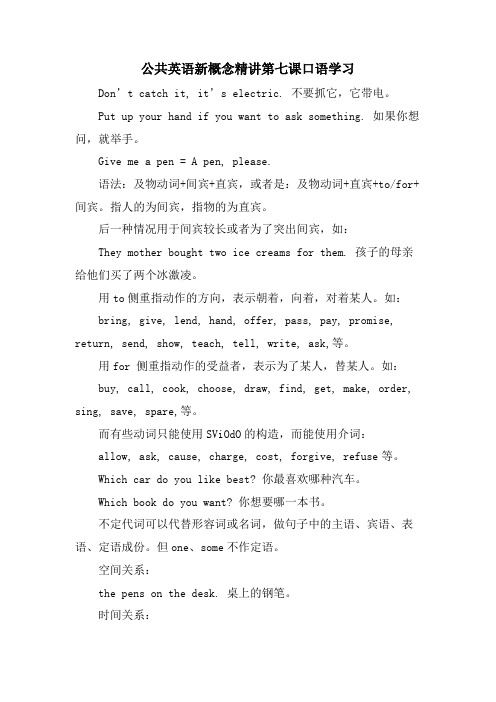
公共英语新概念精讲第七课口语学习Don’t catch it, it’s electric. 不要抓它,它带电。
Put up your hand if you want to ask something. 如果你想问,就举手。
Give me a pen = A pen, please.语法:及物动词+间宾+直宾,或者是:及物动词+直宾+to/for+间宾。
指人的为间宾,指物的为直宾。
后一种情况用于间宾较长或者为了突出间宾,如:They mother bought two ice creams for them. 孩子的母亲给他们买了两个冰激凌。
用to侧重指动作的方向,表示朝着,向着,对着某人。
如:bring, give, lend, hand, offer, pass, pay, promise, return, send, show, teach, tell, write, ask,等。
用for 侧重指动作的受益者,表示为了某人,替某人。
如:buy, call, cook, choose, draw, find, get, make, order, sing, save, spare,等。
而有些动词只能使用SViOdO的构造,而能使用介词:allow, ask, cause, charge, cost, forgive, refuse等。
Which car do you like best? 你最喜欢哪种汽车。
Which book do you want? 你想要哪一本书。
不定代词可以代替形容词或名词,做句子中的主语、宾语、表语、定语成份。
但one、some不作定语。
空间关系:the pens on the desk. 桌上的钢笔。
时间关系:on the mother’s day 在母亲节天。
因果关系:high on dope 因吸毒而兴奋。
介词与其它词类固定搭配可以构成短语,但短语的词性却不确定:go on v. 继续下去, 过去, 发生, 依靠, 接近, 进展, 依据on duty adv.值日on foot adv.徒步on time adv.准时the magazine on the bed. 杂志在书的上面。
英语口才班教案模板范文
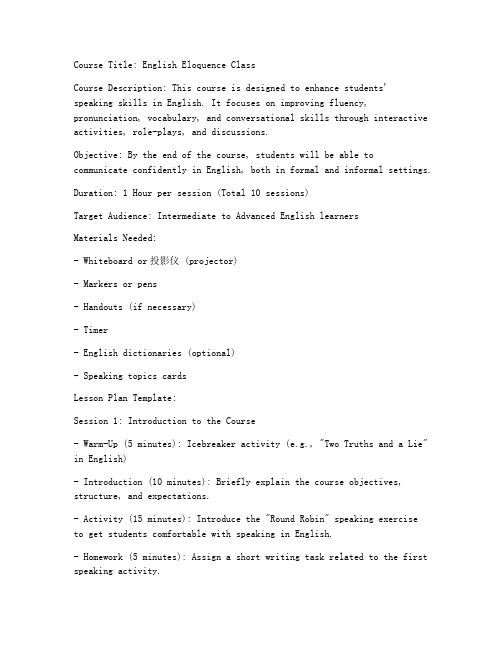
Course Title: English Eloquence ClassCourse Description: This course is designed to enhance students' speaking skills in English. It focuses on improving fluency, pronunciation, vocabulary, and conversational skills through interactive activities, role-plays, and discussions.Objective: By the end of the course, students will be able to communicate confidently in English, both in formal and informal settings.Duration: 1 Hour per session (Total 10 sessions)Target Audience: Intermediate to Advanced English learnersMaterials Needed:- Whiteboard or投影仪 (projector)- Markers or pens- Handouts (if necessary)- Timer- English dictionaries (optional)- Speaking topics cardsLesson Plan Template:Session 1: Introduction to the Course- Warm-Up (5 minutes): Icebreaker activity (e.g., "Two Truths and a Lie" in English)- Introduction (10 minutes): Briefly explain the course objectives, structure, and expectations.- Activity (15 minutes): Introduce the "Round Robin" speaking exercise to get students comfortable with speaking in English.- Homework (5 minutes): Assign a short writing task related to the first speaking activity.Session 2: Pronunciation Basics- Warm-Up (5 minutes): Repeat the icebreaker activity from the previous session.- Lesson (10 minutes): Introduce key pronunciation tips and techniques (e.g., vowel sounds, consonant clusters).- Activity (15 minutes): Practice pronunciation through tongue twisters and listening exercises.- Homework (5 minutes): Record yourself reading a paragraph aloud and analyze your pronunciation.Session 3: Vocabulary Building- Warm-Up (5 minutes): Review the pronunciation exercises from the previous session.- Lesson (10 minutes): Introduce new vocabulary related to a specific theme (e.g., "Workplace").- Activity (15 minutes): Engage in a vocabulary game or a "Word Association" activity.- Homework (5 minutes): Create a vocabulary list of new words learned in the session.Session 4: Advanced Grammar- Warm-Up (5 minutes): Review the vocabulary exercises from the previous session.- Lesson (10 minutes): Teach a grammar point relevant to the students' level (e.g., perfect tenses).- Activity (15 minutes): Practice grammar through exercises and real-life examples.- Homework (5 minutes): Write a short paragraph using the new grammar point.Session 5: Public Speaking Skills- Warm-Up (5 minutes): Review the grammar exercises from the previous session.- Lesson (10 minutes): Discuss the importance of public speaking and its applications.- Activity (15 minutes): Conduct a short presentation by each student on a chosen topic.- Homework (5 minutes): Research a famous public speaker and prepare a summary of their key speaking techniques.Session 6: Conversational English- Warm-Up (5 minutes): Review the presentation skills from the previous session.- Lesson (10 minutes): Introduce conversational phrases and techniques for different situations.- Activity (15 minutes): Engage in a role-play activity to practice conversational English.- Homework (5 minutes): Prepare a list of common conversational phrases for future reference.Session 7: Listening Comprehension- Warm-Up (5 minutes): Review the conversational exercises from the previous session.- Lesson (10 minutes): Discuss strategies for improving listening comprehension in English.- Activity (15 minutes): Listen to a short English audio clip and answer comprehension questions.- Homework (5 minutes): Watch a short English video and summarize the main points.Session 8: Pronunciation and Intonation- Warm-Up (5 minutes): Review the listening exercises from the previous session.- Lesson (10 minutes): Focus on intonation patterns and stress in English.- Activity (15 minutes): Practice intonation through reading exercises and feedback from the instructor.- Homework (5 minutes): Record yourself reading a paragraph aloud and analyze your intonation.Session 9: Advanced Vocabulary and Idioms- Warm-Up (5 minutes): Review the intonation exercises from the previous session.- Lesson (10 minutes): Introduce advanced vocabulary and idioms commonly used in English.- Activity (15 minutes): Engage in a "Word of the Day" activity to expand vocabulary.- Homework (5 minutes): Research and learn the meanings of three new idioms.Session 10: Course Review and Assessment- Warm-Up (5 minutes): Review the idioms from the previous session.- Lesson (10 minutes): Summarize the key points covered throughout the course.- Activity (15 minutes): Conduct a final speaking assessment where students present a short speech on a chosen topic.- Homework (5 minutes): Reflect on the learning experience and set personal goals for future improvement.Evaluation:- Active participation in class activities- Completion of homework assignments- Improvement in speaking fluency and confidence- Feedback from peer assessments and instructor evaluationsNote: This template can be adjusted according to the specific needs and progress of the students. Regular feedback and assessments should be provided to ensure continuous improvement.。
2023年北京卷英语真题(含答案解析)
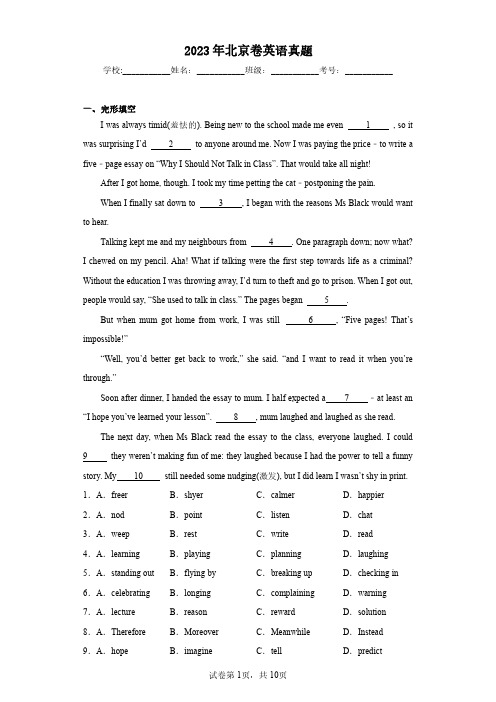
2023年北京卷英语真题学校:___________姓名:___________班级:___________考号:___________10.A.patience B.confidence C.tolerance D.independence三、阅读理解The International Olympic Committee(IOC)Young Leaders programme empowers talents to make a positive difference in their communities through sport.Twenty-five Young Leaders are being selected every two years for a four-year period.They promote the Olympic values,spreading the message of sport for good.To be an IOC Young Leader,you need to first complete the4-Week Learning Sprint(冲刺).4-Week Learning SprintThe4-Week Learning Sprint,which will take place during November2023,is a virtual learning programme.The sessions can be attended live or watched back after they are made available on the IOC channel.Each week,participants will be asked to complete a topic﹣specific reflection task.The4-Week Learning Sprint is open to anyone,with the target audience aged between 20and28.After successfully completing the4-Week Learning Sprint,you will need to submit a plan for a sport﹣based project,which you will work on if selected as an IOC Young Leader.Requirements for the Applicants•You have successfully completed the4-Week Learning Sprint.•You have completed your high school studies.•You have at least one year of work experience.•You have strong public speaking skills.•You are self-motivated and committed.•You are passionate about creating positive change in your community.•You are open to being coached and advised by experts and peers(同伴).•You are able to work with people from different backgrounds.21.In the4-Week Learning Sprint,participants will________.A.create change in their community B.attend a virtual learning programme C.meet people from different backgrounds D.promote the IOC Young Leaders project 22.If selected as an IOC Young Leader,one will need to________.A.complete a reflection task each week B.watch sports on the IOC channelC.work on a sport-based project D.coach and advise their peers 23.Which is a requirement for the applicants?A.Spreading the message of sport for good.B.Having at least one-year workexperience.C.Showing great passion for project planning.D.Committing themselves tobecoming an expert.Sitting in the garden for my friend’s birthday.I felt a buzz(振动)in my pocket.My heart raced when I saw the email sender’s name.The email started off:“Dear Mr Green,thank you for your interest”and“the review process took longer than expected.”It ended with“We are sorry to inform you…”and my vision blurred(模糊).The position—measuring soil quality in the Sahara Desert as part of an undergraduate research programme—had felt like the answer I had spent years looking for.I had put so much time and emotional energy into applying,and I thought the rejection meant the end of the road for my science career.So I was shocked when,not long after the email,Professor Mary Devon,who was running the programme,invited me to observe the work being done in her lab.I jumped at the chance,and a few weeks later I was equally shocked—and overjoyed—when she invited me to talk with her about potential projects I could pursue in her lab.What she proposed didn’t seem as exciting as the original project I had applied to,but I was going to give it my all.I found myself working with a robotics professor on techniques for collecting data from the desert remotely.That project,which I could complete from my sofa instead of in the burning heat of the desert,not only survived the lockdown but worked where traditional methods didn’t.In the end,I had a new scientific interest to pursue.When I applied to graduate school,I found three programmes promising to allow me to follow my desired research direction.And I applied with the same anxious excitement as before.When I was rejected from one that had seemed like a perfect fit,it was undoubtedly difficult.But this time I had the perspective(视角)to keep it from sending me into panic.It helped that in the end I was accepted into one of the other programmes I was also excited about.Rather than setting plans in stone,I’ve learned that sometimes I need to take the opportunities that are offered,even if they don’t sound perfect at the time,and make the most of them.24.How did the author feel upon seeing the email sender’s name?A.Anxious.B.Angry.C.Surprised.D.Settled.25.After talking with Professor Devon,the author decided to________.A.criticise the review process B.stay longer in the Sahara DesertC.apply to the original project again D.put his heart and soul into the lab work 26.According to the author,the project with the robotics professor was________.A.demanding B.inspiring C.misleading D.amusing 27.What can we learn from this passage?A.An invitation is a reputation.B.An innovation is a resolution.C.A rejection can be a redirection.D.A reflection can be a restriction.In recent years,researchers from diverse fields have agreed that short-termism is now a significant problem in industrialised societies.The inability to engage with longer-term causes and consequences leads to some of the world’s most serious problems:climate change, biodiversity collapse,and more.The historian Francis Cole argues that the West has entered a period where“only the present exists,a present characterised at once by the cruelty of the instant and by the boredom of an unending now”.It has been proved that people have a bias(偏向)towards the present,focusing on loud attractions in the moment at the expense of the health,well-being and financial stability of their future selves or community.In business,this bias surfaces as short-sighted decisions. And on slow-burning problems like climate change,it translates into the unwillingness to make small sacrifices(牺牲)today that could make a major difference tomorrow.Instead,all that matters is next quarter’s profit,or satisfying some other near-term desires.These biased perspectives cannot be blamed on one single cause.It is fair to say,though, that our psychological biases play a major role.People’s hesitancy to delay satisfaction is the most obvious example,but there are others.One of them is about how the most accessible information in the present affects decisions about the future.For instance,you might hear someone say:“It’s cold this winter,so I needn’t worry about global warming.”Another is that loud and urgent matters are given too much importance,making people ignore longer-term trends that arguably matter more.This is when a pop star draws far more attention than,say, gradual biodiversity decline.As a psychologist once joked,if aliens(外星人)wanted to weaken humanity,they wouldn’t send ships;they would invent climate change.Indeed,when it comes to environmental transformations,we can develop a form of collective“poor memory”,andeach new generation can believe the state of affairs they encounter is nothing out of the ordinary.Older people today,for example,can remember a time with insect-covered car windscreens after long drives.Children,on the other hand,have no idea that insect population has dropped dramatically.28.The author quotes Francis Cole mainly to________.A.draw a comparisonB.introduce a topicC.evaluate a statementD.highlight a problem29.What can be inferred from the last paragraph?A.Climate change has been forgotten.B.Lessons of history are highly valued.C.The human mind is bad at noting slow change.D.Humans are unwilling to admit their shortcomings.30.What does the author intend to tell us?A.Far-sighted thinking matters to humans.B.Humans tend to make long-term sacrifices.C.Current policies facilitate future decision-making.D.Bias towards the present helps reduce near-term desires.What is life?Like most great questions,this one is easy to ask but difficult to answer. The reason is simple:we know of just one type of life and it’s challenging to do science with a sample size of one.The field of artificial life-called ALife for short—is the systematic attempt to spell out life’s fundamental principles.Many of these practitioners,so-called ALifers,think that somehow making life is the surest way to really understand what life is.So far no one has convincingly made artificial life.This track record makes ALife a ripe target for criticism,such as declarations of the field’s doubtful scientific value.Alan Smith,a complexity scientist,is tired of such complaints.Asking about“the point”of ALife might be, well,missing the point entirely,he says.“The existence of a living system is not about the use of anything.”Alan says.“Some people ask me,‘So what’s the worth of artificial life?’Do you ever think,‘What is the worth of your grandmother?’”As much as many ALifers hate emphasizing their research’s applications,the attempts to六、建议信44.假设你是红星中学高三学生李华。
七年级上册英语作文50字左右

The Exciting Journey of Learning English inGrade 7In the threshold of adolescence, our journey with English in Grade 7 unfolds like an enchanting tale. This is not merely about memorizing grammar rules or expanding vocabulary; it's a voyage of self-discovery and cultural exploration.English, often referred to as the global lingua franca, opens doors to a world beyond our immediate surroundings.It becomes our compass, guiding us through the vast ocean of knowledge. In our Grade 7 curriculum, each lesson is a stepping stone, leading us closer to understanding the intricacies of this language.Our textbooks, filled with captivating stories and engaging exercises, are our trusty companions. They introduce us to diverse characters, teaching empathy and broadening our perspectives. We learn about Harry Potter's magical adventures, inspiring us to dream big. The poems, with their rhythmic beauty, instill in us a love for literature.Grammar lessons, though initially daunting, soon become fascinating puzzles to solve. Understanding the nuances of tenses equips us to narrate our own tales, be it athrilling adventure or a simple day at school. Vocabulary expansion becomes a game, as we eagerly collect new words like precious gems.Moreover, the class discussions and debates stimulate critical thinking. They encourage us to express our opinions, fostering confidence and public speaking skills. The joy of participating in role-plays, mimicking accents, and bringing characters to life adds a touch of drama to our learning process.Homework, often seen as a chore, transforms into a platform for creativity. We pen down our thoughts, weaving narratives, and expressing emotions. Each written word is a testament to our growing proficiency.Moreover, the influence of technology amplifies our learning. Online resources, interactive quizzes, and educational apps make learning fun and interactive. We engage in virtual conversations, improving our listening and speaking abilities.Yet, the true essence of learning lies not just in the curriculum but also in the friendships forged. We bond over shared struggles, celebrate victories together, and motivate each other to keep improving.Grade 7, thus, marks the beginning of a profound relationship with English. It's a year of challenges, triumphs, and transformation. As we navigate through this journey, we realize that learning English is not just about mastering a language; it's about embracing a new way of seeing and understanding the world.In conclusion, the journey of learning English in Grade 7 is a roller-coaster ride of excitement and growth. It shapes our minds, enhances our communication skills, and paves the way for a lifetime of learning. So, let's embrace this journey with open hearts and curious minds, ready to unlock the endless possibilities that English has to offer.。
英语组听课月听评课总结英语公开课评课记录
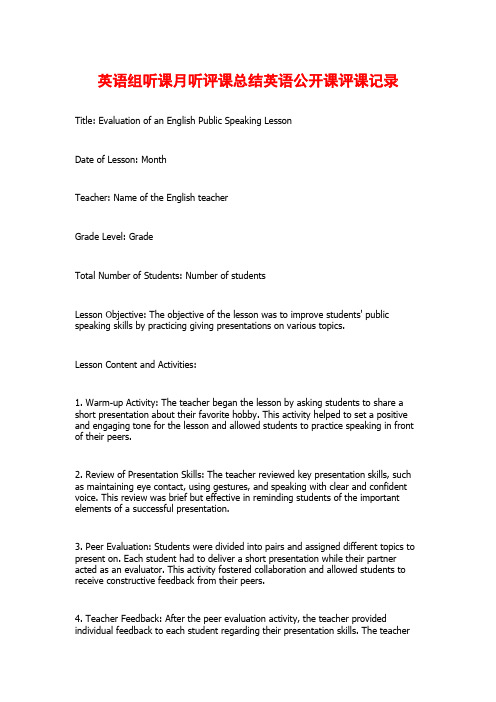
英语组听课月听评课总结英语公开课评课记录Title: Evaluation of an English Public Speaking LessonDate of Lesson: MonthTeacher: Name of the English teacherGrade Level: GradeTotal Number of Students: Number of studentsLesson Objective: The objective of the lesson was to improve students' public speaking skills by practicing giving presentations on various topics.Lesson Content and Activities:1. Warm-up Activity: The teacher began the lesson by asking students to share a short presentation about their favorite hobby. This activity helped to set a positive and engaging tone for the lesson and allowed students to practice speaking in front of their peers.2. Review of Presentation Skills: The teacher reviewed key presentation skills, such as maintaining eye contact, using gestures, and speaking with clear and confident voice. This review was brief but effective in reminding students of the important elements of a successful presentation.3. Peer Evaluation: Students were divided into pairs and assigned different topics to present on. Each student had to deliver a short presentation while their partner acted as an evaluator. This activity fostered collaboration and allowed students to receive constructive feedback from their peers.4. Teacher Feedback: After the peer evaluation activity, the teacher provided individual feedback to each student regarding their presentation skills. The teacherpraised strengths and offered suggestions for improvement, ensuring that students received personalized guidance.5. Group Presentation: The lesson ended with students forming small groups and presenting a group presentation on a given topic. This activity encouraged teamwork and allowed students to practice their public speaking skills in a supportive and collaborative environment.Strengths:1. Engaging Warm-up Activity: The warm-up activity at the beginning of the lesson was well-designed and helped to create a positive and interactive learning atmosphere.2. Peer Evaluation: Peer evaluation provided students with an opportunity to give and receive feedback from their classmates. This activity promoted active learning and encouraged students to critically analyze and improve their presentation skills.3. Clear Communication: The teacher effectively conveyed the expectations and objectives of the lesson to the students. The instructions were clear and concise, ensuring that all students understood what was expected of them.Areas for Improvement:1. Time Management: The teacher could have better managed the time allocated for each activity. Some activities took longer than anticipated, causing the lesson to run over the scheduled time.2. Student Engagement: Although the activities were engaging, a few students seemed disengaged during parts of the lesson. The teacher should consider incorporating more interactive and hands-on activities to ensure that all students are actively participating and learning.Overall, the English public speaking lesson was well-structured and provided students with the opportunity to practice and improve their presentation skills. The teacher effectively incorporated engaging activities and provided individualized feedback to students. With some attention to time management and student engagement, this lesson could be further enhanced to ensure maximum learning outcomes for all students.。
英语听说2020年精选试题e套
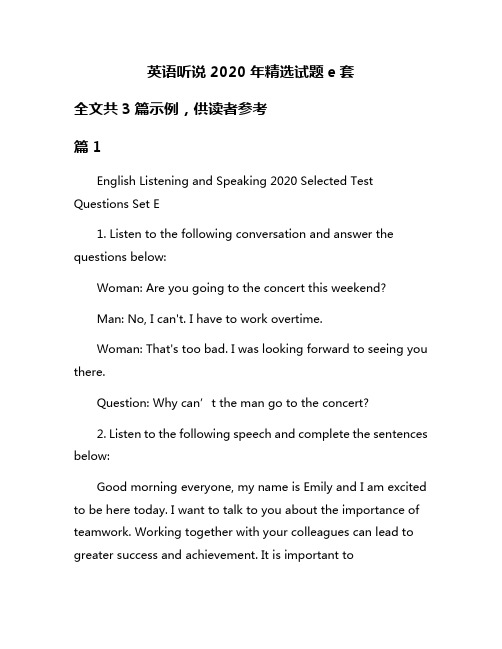
英语听说2020年精选试题e套全文共3篇示例,供读者参考篇1English Listening and Speaking 2020 Selected Test Questions Set E1. Listen to the following conversation and answer the questions below:Woman: Are you going to the concert this weekend?Man: No, I can't. I have to work overtime.Woman: That's too bad. I was looking forward to seeing you there.Question: Why can’t the man go to the concert?2. Listen to the following speech and complete the sentences below:Good morning everyone, my name is Emily and I am excited to be here today. I want to talk to you about the importance of teamwork. Working together with your colleagues can lead to greater success and achievement. It is important tocommunicate effectively and support each other to reach our goals. Remember, there is no “I” in team!Question: According to the speaker, what is the key to achieving success through teamwork?3. Listen to the following audio clip and answer the question below:Interviewer: Can you tell us about a time when you had to deal with a difficult situation at work and how you resolved it?Candidate: Sure, there was a conflict between two team members, so I stepped in to mediate and helped them find a compromise that satisfied both parties.Question: How did the candidate resolve the conflict between the two team members?4. Listen to the dialogue below and choose the best response to the question:Woman: Excuse me, do you know where the nearest post office is?Man: Yes, it's just around the corner on Maple Street.Woman: Thank you so much!Question: What does the man say about the location of the post office?5. Listen to the following monologue and answer the question below:In today's class, we will be discussing the importance of time management. It is crucial to prioritize tasks and allocate time efficiently to maximize productivity. By setting clear goals and deadlines, you can stay organized and focused on achieving success in both your personal and professional life.Question: What is the speaker's main point about time management?6. Listen to the conversation below and complete the sentences:Woman: Have you finished writing your report for the meeting tomorrow?Man: No, I haven't had a chance to start yet. I've been swamped with other projects.Woman: Don't worry, I can help you with it. Let's work on it together tonight.Question: Why hasn't the man finished his report for the meeting?7. Listen to the following audio clip and answer the question below:Interviewer: Can you tell me about a time when you had to think outside the box to solve a problem at work?Candidate: Certainly, when our project faced unexpected obstacles, I suggested a creative solution that ultimately saved us time and resources.Question: How did the candidate's creative solution benefit the project?8. Listen to the dialogue below and choose the best response to the question:Woman: Would you like to join us for dinner tonight?Man: Thanks for the invitation, but I already have plans with my family.Question: What is the man's response to the invitation?9. Listen to the following monologue and answer the question below:As we wrap up our lesson on public speaking skills, I want to emphasize the importance of practicing and preparing for your presentations. By rehearsing your speech multiple times and seeking feedback from others, you can build confidence and deliver a compelling message to your audience.Question: What is the speaker's advice for improving public speaking skills?10. Listen to the conversation below and complete the sentences:Woman: I can't find my keys anywhere. Have you seen them?Man: I think I saw them on the kitchen table this morning.Woman: Oh, you're right! I must have left them there by accident.Question: Where did the man see the woman's keys in the morning?These are just a few examples of the types of questions you may encounter in the English Listening and Speaking 2020 Selected Test Questions Set E. Remember to practice active listening and critical thinking to excel in your language skills. Good luck!篇2Title: Selected English Listening and Speaking Questions for 2020Introduction:In this document, we will present a collection of selected English listening and speaking questions for the year 2020. These questions cover a wide range of topics and are designed to test the listening and speaking skills of English language learners. By practicing with these questions, students can improve their English proficiency and prepare for various English exams and assessments.Listening Section:1. Listen to a conversation between two friends discussing their weekend plans. Answer the following questions:- Where are they planning to go?- What activities do they plan to do?2. Listen to a news report about the environment. Answer the following questions:- What are some of the environmental issues mentioned in the report?- What solutions are proposed to address these issues?3. Listen to an academic lecture on the history of the United States. Answer the following questions:- What are some key events discussed in the lecture?- How did these events shape the history of the country?Speaking Section:1. Describe your favorite holiday destination. What do you like about it? Would you recommend it to others?2. Discuss the impact of technology on modern society. How has technology changed the way we live and work? What are some pros and cons of technological advancements?3. Talk about a memorable experience you had while traveling. Where did you go? What did you do? How did it impact you?Conclusion:Practicing with these selected English listening and speaking questions can help students improve their English skills and become more proficient in the language. By exploring a variety of topics and responding to different types of questions, learnerscan enhance their ability to comprehend and communicate in English effectively.篇3English Listening and Speaking 2020 Selected Test Questions (Set E)Part 1: Listening ComprehensionSection A: Understanding Dialogues1. Listen to the following dialogue and answer the questions:A: What are you doing this weekend?B: I'm going camping with my family. How about you?A: I'm going to a concert on Saturday.Questions:1. What is person A doing this weekend?2. What is person B doing this weekend?2. Listen to the following dialogue and answer the questions:A: Did you finish the report for the meeting?B: No, I haven't had time to complete it yet.A: Can you have it done by tomorrow morning?Questions:1. Did person B finish the report for the meeting?2. When does person A want the report to be completed?Section B: Understanding Monologues1. Listen to the following monologue about a trip to Paris. Answer the questions after listening.Question:What were the three main attractions the speaker visited in Paris?2. Listen to the following monologue about a famous scientist. Answer the questions after listening.Question:What were the key contributions of the scientist mentioned in the monologue?Part 2: SpeakingSection A: Expressing Opinions1. Do you prefer living in a big city or a small town? Explain your choice.2. What is your favorite way to relax after a long day? Share your thoughts.Section B: Describing Images1. Look at the picture and describe what you see.2. Look at the image and talk about where you think it was taken and what might be happening.Section C: Role-Play1. Role-play a situation where you are asking for directions to a nearby restaurant.2. Role-play a scenario where you are negotiating with a colleague over a project deadline.These are some sample questions from the English Listening and Speaking test for the year 2020. Practice these questions to improve your skills in understanding spoken English and expressing yourself confidently in English conversations. Good luck!。
- 1、下载文档前请自行甄别文档内容的完整性,平台不提供额外的编辑、内容补充、找答案等附加服务。
- 2、"仅部分预览"的文档,不可在线预览部分如存在完整性等问题,可反馈申请退款(可完整预览的文档不适用该条件!)。
- 3、如文档侵犯您的权益,请联系客服反馈,我们会尽快为您处理(人工客服工作时间:9:00-18:30)。
Lesson 7 Public Speaking in Interpreting Learning ObjectivesBy the end of this Chapter, you should be able to●Have an idea of the basic requirements for public speaking●Be aware of the significance of audience analysis in public speakingDo some interpretation exercises.I. Definition of public speakingPublic speaking is the process of speaking to a group of people in a structured, deliberate manner intended to inform, influence, or entertain the listeners. In the four processes of interpreting: listening, memorizing, processing and delivering, the last step actually plays the important role of public speaking. An interpreter, though a secondary speaker, makes great target-language impact on the first speaker on the spot, especially in consecutive interpreting. Therefore, a good interpreter, first and most, is an outstanding public speaker. Public speaking in interpreting is a communication in essence; a communication among audience, speakers and interpreters A good public speaking in interpreting undoubtedly increases audience and speakers’ trust in the interpreter and his interpreting quality. To make a good public speaking, an interpreter could train himself from the following three aspects: proper voice, proper body language, and proper strategy.II. Some basic requirements for public speaking1. Proper voiceTo a large extent, the effect of interpreting is determined by the interpreter’s voice. An interpreter’s voice bridges the communication, and a good interpreter is competent of using his voice properly to meet the demand of smooth and successful communication. How to control his voice scientifically and how to use his voice artfully are compulsory to learn for all the interpreters.(1)correctnessAn interpreter must focus on voice projection and articulation, as they are the important carriers of voice. Good-to-ear voice and standard articulation weigh much to the training of public speaking.(2)toneA mellow, clear and bright voice is the most ideal one; a sharp or hoarse voice discomforts the audience.(3) pitchPitch refers to the loudness or lowness of one’s voice, which is, generally speaking, high, modest, and low voice. High voice in interpreting could bring surprise, joy and praise, while it is inclined to create an anxious atmosphere. High voice for a long time, in all likelihood, exhausts audience. Modest voice, relatively rich and substantial, conveys the mild and moderate emotion. Low voice, however, frequently applies to the case of gloom and grief. For most interpreting occasions, modest and moderate voice is recommended. But a good and qualified interpreter is able to adjusthis pitch to various cases.(4) intonationIntonation is changes about voice fall and rise. Changes in intonation are based on the interpreter’s understanding of source language and the context on the spot. A qualified interpreter will use appropriate, natural and nice intonation to keep audiences’ attention and deliver the fullest contents and sensibilities of the speaker.(5)speedToo fast and too slow are two extremes in interpreting. Under intensive interpreting, an inexperienced interpreter will subconsciously quicken his speed, sometimes words or sentences missing, which fail the audience to catch up with and the audiences lose their interest, trust and patience. Here is a good tip for public speaking speed: the more audience, the moderately slower your speech speed than average. Meanwhile, fast and slow deliveries are alternative in live interpreting, as well as by means of pause and stress.(6) volumeThe basic requirement of public speaking is clearly audible and intelligible. A qualified interpreter, especially in conference interpreting and simultaneous interpreting, will professionally watch and adjust his microphone position and volume, i.e. microphone manners. A certain distance should be kept between interpreter’s mouth and microphone to prevent from distorted sound and pop noise, from gasping, sniffing, coughing and noise-making data reading. To keep voice stable and clear, especially when an interpreter lowers his head to read notes, he will keep a little closer to microphone.2. Proper Body languageBody language is a form of non-verbal communication, which consists of body posture, gestures, facial expressions, and eye movements. Humans send and interpret such signals subconsciously. Body language may provide clues as to the attitude or state of mind of a person. For example, it may indicate aggression, attentiveness, boredom, relaxed state, pleasure, amusement, and intoxication, among many other cues. Therefore, body language is message carrier of communication, which is taken as an indispensable part of public speaking. As an interpreter, he excels not only in verbal expression, but in using body language to complete and compensate meanings and feelings.(1)appearance and presenceAppearance and presence is the initial visual image and non-verbal body language when an interpreter is on the stage or on the spot. Audiences observe his appearance and presence, guessing and creating the first impression on him, which makes directly impact on the interpreting effect. Natural and graceful appearance and presence is the respect to audience that narrows the psychological gap between audience and the interpreter; that wins the attention and respect from audience, and in turn creating harmonious atmosphere. How to have a good appearance and presence? Formal dress or informal dress? The simplest way is to communicate with the host or sponsor and to make an elegant and tact dress.(2) poseProper pose is necessary in public speaking. Standing, sitting or stepping, an interpreter has to be modest and natural. Stand and sit stably, vigorously and energetically; try not to cross legs, shake or lean, bow or bend, look back and forth or left and right. Hands can be seen and available, while it is improper to play with fingers or the corners of clothes, even it is no need taking notes.(3) eye contactEyes are the windows of one’s soul so that calm and confident eye contact is the most exact and active bridge of communication. An interpreter’s proper eye contact impresses audience like an individual contact. A sophisticated interpreter will hold every listener in his eyes, pause or ponder when he sees audience confusing, adjust his interpreting by occasionally looking at audiences and reading notes or references alternatively.(4)facial expressionProper facial expression could convey messages and emotions effectively. Elegant and earnest, calm and confident, affable and amiable facial expression will narrow the distance, double the interpreting effect, and add the mutual trust. Better not exaggerate one’s facial expression, nor be glassy-eyed or a poke face. Try not to frown, make faces and a miserable face, tongue out, and sigh. When there is a slip of the tongue, an interpreter should accept criticism or correctness modestly rather than to frown or pull a straight face. Above-mentioned taboos easily result in adverse effect and lead to centrifugal effect in the end.(5) gestureProper gesture can refine the interpreting; too many gestures of an interpreter are to gild the lily, imperceptibly distracting audiences’attention and dissatisfied them. An experienced interpreter could use gestures moderately and consciously, meanwhile avoid scratching his ears or cheeks.3. Proper strategiesHere are some proper strategies on public speaking training for an interpreter.(1) To have a good habit of completing a sentence after starting interpreting. Better not be a brave beginning and weak ending, nor restart interpreting, nor have constant back-correction.(2) As for the issue of first person or third person in interpreting, generally speaking, first person is more favored in practice. It is the international practice that an interpreter informs the audience the nationality, title and name of the spokesman or spokeswoman and using the first person. But an interpreter takes the interpreting role for many speakers in two-sided or multilateral conference; he should state explicitly the spokesman identity.(3) To train his eloquence in public speaking, an interpreter is recommended to practice three-point skill. That is, to talk three points or three aspects whatever topic or opinion is given, for instance, put forward three evidences, give three reasons or make three examples. Psychologically speaking, two points are insufficient to most audience; four are redundant and easily to forget the second point; three is appropriate and right.Practice of public speakingExercise 1Listen to the following texts once and then start interpreting at the end of each segment.Secretary-General's remarks to the Memorial Ceremony in honor of those killed in the Haiti earthquake in New York, 9 March 2010Excellencies,Dear colleagues,Dear friends,Above all, dear families of those to whom we sadly bid farewell://Let us begin by thanking the families and friends who have traveled far to be with us. To those who could not be here, please know that our hearts are with you. //We are joined by duty stations around the world, the men and women of our proud United Nations. Among them are the members of our UN mission in Haiti, who have carried on despite their pain and hardship. // I thank Mr. Edmond Mulet and his courageous staff who are working tirelessly - day in, day out – in MINUSTAH [UN Stabilization Mission in Haiti]. I highly commend [you] and I am deeply grateful to all of you. //Today, we commemorate the single greatest loss the UN has suffered in its history. We remember 101 lives of consequence. We honor 101 unique paths that joined in Haiti to write the larger story of the United Nations. These women and men were our own. They were family.//They came to Haiti from all corners of the world, from all walks of life. Yet they shared a common conviction, a belief in a better future for the people of Haiti, and a common resolve to help them build it. Now those 101 paths come together one final time, here in this chamber, through us - families and friends, colleagues and loved ones.//The world knew them as trusted diplomats, dedicated humanitarians and conscientious professionals. They were doctors and drivers, police officers and policy advisers, soldiers and lawyers, each contributing to the mission, each in his or her own way.//To us they were even more. We knew them, very personally. We knew their smiles, their songs, their dreams. Now we cannot forget the last email, the last conversation, the last meal together, the last au revoir. Their words echo: "Don't worry about me. This is where I need to be. //"At the United Nations, we don't simply share office space; we share a passion for a better world. So it is no surprise that many of these 101 paths crisscrossed the globethrough the years: in Cambodia and the DRC, Eritrea and East Timor, Kosovo and Sierra Leone. //Whether they came to Haiti, or came from Haiti, they knew that hope shines in even the darkest corners. And so they chased the flame. Wherever they went, they carried the light of hope. //And as they fulfilled their mission in Haiti, they illuminated a profound truth: Earthquakes are a force of nature, but people move the world. //Key words:duty stations:工作地点mission: 任务MINUSTAH(UN Stabilization Mission in Haiti): 联合国海地特派团Commemorate: 缅怀lives of consequence :英烈humanitarian: 人道主义工作者conscientious:良知的crisscrossed:纵横交错的Cambodia:柬埔寨DRC(democratic republic of Congo):刚果民主共和国Eritrea: 厄立特里亚East Timor: 东帝汶Kosovo: 科索沃Sierra Leone: 塞拉利昂Exercise 2胡锦涛在上海世博会欢迎晚宴上的祝酒辞尊敬的国际展览局蓝峰主席、洛塞泰斯秘书长,尊敬的各位国家元首、政府首脑、议长和王室代表,尊敬的各位国际组织代表,尊敬的各位来宾,女士们,先生们,朋友们: //今晚,2010年上海世界博览会将隆重开幕。
